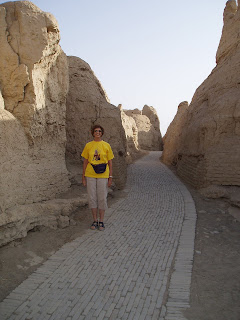 One was an old village with people living in small houses built amidst crumbling ruins. In interesting contrast, to say the least. The people are Muslim in this area so didn't want us to take their pictures, however we did get this picture of bread baking in an outdoor, open oven. The woman stuck the dough on the side of the oven and baked it there. Then she flipped it off the oven into a bowl. It looked like a half bagel and smelled delicious.
One was an old village with people living in small houses built amidst crumbling ruins. In interesting contrast, to say the least. The people are Muslim in this area so didn't want us to take their pictures, however we did get this picture of bread baking in an outdoor, open oven. The woman stuck the dough on the side of the oven and baked it there. Then she flipped it off the oven into a bowl. It looked like a half bagel and smelled delicious.  We spent quite a while wandering through the town. One of the things we noticed was that many of the houses had beds on the roofs. (A word about beds in China. They are HARD. Many are just a board with a cloth over them.) That was what we saw on top of the houses. Many of the houses just had a bed on the front porch like the ones in the picture. The guide told us it is too hot and dry for mosquitos so the people sleep on the roof to keep cool. Some houses had branches spread over the top to let in air and keep out the sun. We also saw tomatoes drying in the sun by a bed on a roof.
We spent quite a while wandering through the town. One of the things we noticed was that many of the houses had beds on the roofs. (A word about beds in China. They are HARD. Many are just a board with a cloth over them.) That was what we saw on top of the houses. Many of the houses just had a bed on the front porch like the ones in the picture. The guide told us it is too hot and dry for mosquitos so the people sleep on the roof to keep cool. Some houses had branches spread over the top to let in air and keep out the sun. We also saw tomatoes drying in the sun by a bed on a roof.Then we went to Gaochang ruins. Gaochang is the ruins of an ancient city on the silk road. It flourished for about 1400 years from the 1st century BC to the 14th century AD when it burned to the ground. The area has not been restored and it is an interesting series of mounds. We could distinguish a wall in the distance as we rode through the area by donkey cart. We did stop for a few minutes to look around, but it is quite
desolate.


From there we went to some Buddhist caves--they are scattered all throughout northwest China. This area was all Buddhist until it converted to Islam somewhere around 1,000 years ago. Now Islam is the dominant religion in the area. But the caves still remain, although Europeans took many of the finest statues, carvings, etc. back to their museums about a hundred years ago.
In the evening we happened upon a fountain and light show in the town square. What a delightful and unexpected surprise! It was not crowded so we sat on a small wall and watched the fountains and listened to both Western and traditional Chinese music as the fountains sprayed in assorted patterns and the lights played upon the water. I liked it as much as anything I've seen in the US--even in Las Vegas.


The next day we visited some other ruins--a place called Jiaohe. These ruins one of the world's largest, oldest and best preserved ruins. They are located on a high plateau between two rivers. The town was built from the top down, meaning that the people started digging from the top and each floor was cut out below the one above it. An interesting way to build a city. We found a man playing traditional Chinese music and stopped for a picture with him--for a price, of course.

In the afternoon we visited the grape growing area. Here is where all the raisins we saw in Urumqi are grown. It was interesting to see the houses of the people, the huge grape orchards, and taste the different kinds of raisins. Some areas had grape arbors that were 20-30 feet wide and a quarter of a mile long. I guess in the heat, these arbors provide some relief and shade. All tours are required to stop here (you pay whether you stop or not, so we stopped) because the governmnet is trying to promote tourism in the area.
That evening we boarded the train for an overnight trip from Turpan to Dunghuang. We had a "soft sleeper"--an oxymoron if I ever heard of one. The bed was not soft and we did not do much sleeping. This is the best the train offered, however. We had a room for 4 people--two bunks on each side. Fortunately, we knew the other people in our room because our tour group filled one and one half cars. We were fortunate enough to be in the car where we knew everyone, but with the toilets at the end of the car and only one washroom--3 sinks,--we got to know everyone even better. At least there was one "western" toilet which we all used. I wondered about using a "squat" toilet when the train was moving and swaying. It is all part of the adventure of China. We wouldn't miss a minute of it--soft sleeper and all.
No comments:
Post a Comment